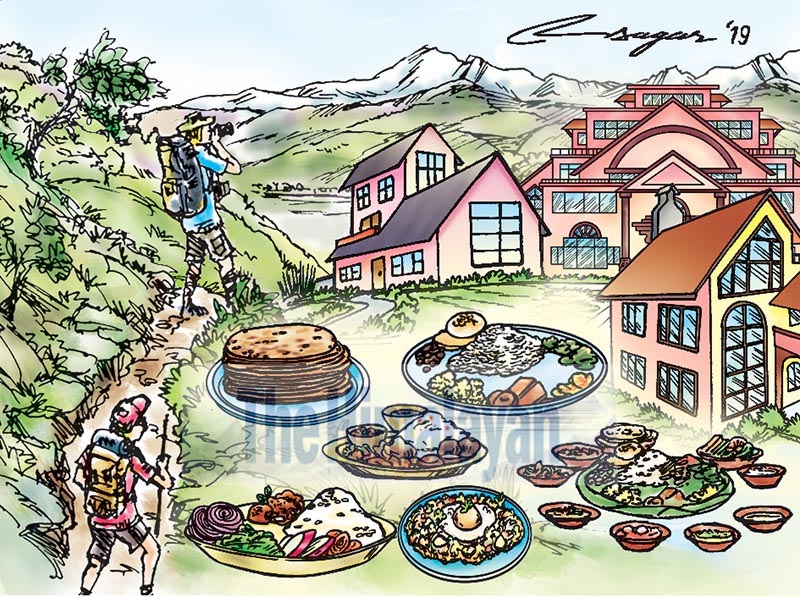Visit Nepal 2020: Why not get more from trekkers?
Without improvements in the trekking sector, Nepal might succeed in attracting two million tourists in 2020, but fail to draw fair benefits. Changes are necessary also to reposition Nepal away from its image as a low-end tourism destination
Himalayan Travel Mart 2019, Nepal’s premier international travel and tourism trade show, concluded amid grand fanfare this week. The grandiose event showcased the substantial efforts the Nepal Tourism Board and private sector actors had put together to organise it and communicate to travellers across the world about the services on offer and preparations for the Visit Nepal 2020.
During the international media briefing session, Suraj Vaidya, the coordinator of the campaign, shared a number of approaches being taken to attract more tourists. When listening to the presentations in the different sessions, just back from a trek in Langtang in April this year, my mind could not stop questioning the need to improve the trekking sector to realise its potential.
Trekking is among the most popular activities for tourists, both Nepali and foreigners. However, the sector can do a lot better with suggestions from trekkers. This article discusses the improvements required based on the one-week-long Langtang trek from Syabrubesi to Tshergo Ri.
The route offered beautiful scenery and fresh air. The clean and fast flowing Langtang Khola, pristine forests and encounter with the goats at the lower elevation and yaks at a higher elevation were really captivating. While the hills in Nepal, including those on the way from Kathmandu, are marred by haphazard excavation of roads and rivers, to my surprise, the Langtang trekking route had not joined this trend, possibly because of its location in the Langtang National Park.
Regarding the facilities, the tea houses were plenty and well located along the route, taking the worry out of trekkers for accommodation and food. However, we realised that the trekkers faced limited choice when it came to food and quality of accommodation.
Instead of offering nearly the same items — with the price increasing with distance from Syabrubesi — the tea houses could diversify the menu and offer better accommodation. More local items could be added to the variants of Tibetan bread, momo (potato, cheese and veggies), dal bhat, thukpa, and tea and coffee. Local organic products, from farms and forests, not only lower the cost of food by saving on the transportation cost, which is more than Rs 50 a kilo, but also add to the experience of the tourists. Trekkers would definitely enjoy sisnu (Himalayan nettle) curry, which was found aplenty along the trail. There are plenty of other edible herbs, too.
Similarly, activities to engage tourists with the local people help amplify the experience of the tourists, providing them a taste of the local culture and arts, as in the Annapurna region. After a tiring walk, trekkers would happily enjoy learning the Hyolmo dance or playing the tungna, while also encouraging locals to preserve their cultural heritage.
Local culinary classes could also be on offer. When stuck at a tea house due to rain, we came up with the idea of making momos ourselves, which engaged us for nearly two hours. Such activities give the local people more jobs and additional sources of income while giving the trekkers an opportunity to learn something exotic.
Furthermore, a modest investment in telecommunication infrastructure in the area and development of an online platform accessible to local tea houses would also help connect trekkers with the local communities and the outside world. Such facilities allow tourists to directly communicate with the tea houses, rather than leaving it to the tourist guides.
More importantly, internet access along the trail would allow trekkers to instantly share beautiful photos of the area and people through the social media. With this, they do not need to wait until they are back from the trek to share a few photos when the energy is already down. Internet access to trekkers would also help advertise Nepal and the trekking trail around the globe at almost no cost.
These suggestions will help monetise local products, unique traditional arts, food and cultural practices while also encouraging tourists to spend more and giving more reasons to revisit the site. The changes will help the Nepali tourism sector to flourish by creating more jobs and help to preserve and give publicity to our culture and native food items and ultimately help in the sustainable development of our trekking destinations. This is necessary also to address the decreasing average spending of tourists in Nepal, which is a seven-year low at $44 a day.
Without these changes, Nepal might succeed in attracting two million tourists as aimed in Visit Nepal 2020, but fail to draw fair benefits. Changes are necessary also to reposition Nepal away from its image as a low-end tourism destination.
However, all this raises important questions: are the local communities and entrepreneurs along the trekking routes open for improvements? Are they willing to be more creative and bring improvements in their business? The government and private sector operators, such as trekking agencies, have a stronger role in supporting the local communities to see a bigger picture and longer-term benefits. Their role is also necessary to encourage creativity and some sort of competition among the local entrepreneurs and scaling up and scale out the working models to other trekking trails. It is all about growing together, but the question again is: are we really open for such a change?






